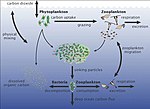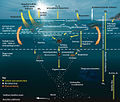Phytoplankton (/ˌfaɪtoʊˈplæŋktən/) are the autotrophic (self-feeding) components of the plankton community and a key part of ocean and freshwater ecosystems...
63 KB (6,497 words) - 03:32, 4 June 2024
Phytoplankton are characterized as organisms which are unable to swim against a current and produce their own organic carbon via photosynthesis. They...
46 KB (4,766 words) - 23:17, 1 June 2024
Algal bloom (redirect from Phytoplankton bloom)
which are algal bloom events involving toxic or otherwise harmful phytoplankton. Many species can cause harmful algal blooms. For example, Gymnodinium...
29 KB (3,358 words) - 10:10, 2 June 2024
Freshwater phytoplankton is the phytoplankton occurring in freshwater ecosystems. It can be distinguished between limnoplankton (lake phytoplankton), heleoplankton...
11 KB (1,298 words) - 12:42, 6 June 2024
the root of the word in the derivation. Some marine diatoms — a key phytoplankton group The amphipod Hyperia macrocephala – part of the zooplankton Plankton...
62 KB (6,475 words) - 10:25, 2 June 2024
Photic zone (section Phytoplankton side notes.)
uppermost layer of a body of water that receives sunlight, allowing phytoplankton to perform photosynthesis. It undergoes a series of physical, chemical...
25 KB (2,955 words) - 08:17, 23 May 2024
chlorophyll pigment, which phytoplankton use to produce carbon by photosynthesis. Chlorophyll, a green pigment, makes phytoplankton preferentially absorb the...
41 KB (4,274 words) - 02:16, 4 June 2024
own food, while phytoplankton can. As a result, zooplankton must acquire nutrients by feeding on other organisms such as phytoplankton, which are generally...
77 KB (7,092 words) - 10:23, 2 June 2024
Marine primary production (redirect from Phytoplankton production)
microscopic organisms called phytoplankton. It has been estimated that half of the world's oxygen is produced by phytoplankton. Larger autotrophs, such as...
82 KB (8,310 words) - 09:21, 2 June 2024
Antarctic Circumpolar Current (section Phytoplankton)
creating a zone of upwelling nutrients. These nurture high levels of phytoplankton with associated copepods and krill, and resultant food chains supporting...
24 KB (2,607 words) - 04:25, 29 April 2024
plant nutrients enter a river, lake, or ocean, and phytoplankton blooms are encouraged. While phytoplankton, through photosynthesis, will raise DO saturation...
17 KB (1,978 words) - 01:27, 17 April 2024
Marine microorganisms (redirect from Marine phytoplankton)
However, phytoplankton numbers are usually kept in check by the phytoplankton exhausting available nutrients and by grazing zooplankton. Phytoplankton consist...
232 KB (21,388 words) - 09:31, 2 June 2024
The spring bloom is a strong increase in phytoplankton abundance (i.e. stock) that typically occurs in the early spring and lasts until late spring or...
18 KB (2,223 words) - 07:14, 19 May 2024
smokestacks or internal combustion engines, sulfate from volcanic activity, phytoplankton or the oxidation of sulfur dioxide and secondary organic matter formed...
19 KB (2,096 words) - 17:42, 27 April 2024
strains the pumped water through its internal feeding filters, feeding on phytoplankton. Salps are common in equatorial, temperate, and cold seas, where they...
16 KB (1,463 words) - 15:53, 27 May 2024
organisms known as phytoplankton. The second trophic level (primary consumers) is occupied by zooplankton which feed off the phytoplankton. Higher order consumers...
158 KB (16,548 words) - 11:10, 2 June 2024
hypothetical surface mixing depth where phytoplankton growth is precisely matched by losses of phytoplankton biomass within the depth interval. This concept...
25 KB (3,435 words) - 16:09, 5 January 2024
Fjord (section Phytoplankton)
deeper areas of the water mass, reducing phytoplankton abundance beneath the surface. Overall, phytoplankton abundance and species composition within...
52 KB (6,175 words) - 12:27, 4 June 2024
Marine fungi (section Algae and phytoplankton)
kilometers below ocean sediments. Fungi are hypothesized to contribute to phytoplankton population cycles and the biological carbon pump and are active in the...
56 KB (5,837 words) - 12:45, 6 June 2024
iron sulfate) to iron-poor areas of the ocean surface to stimulate phytoplankton production. This is intended to enhance biological productivity and/or...
98 KB (10,252 words) - 11:46, 2 June 2024
Black Sea (section Phytoplankton)
rich layers known as sapropels. Scientists have reported an annual phytoplankton bloom that can be seen in many NASA images of the region. As a result...
117 KB (11,712 words) - 14:07, 8 June 2024
prokaryotes archaea and bacteria. Diatoms are a type of plankton called phytoplankton, the most common of the plankton types. Diatoms also grow attached to...
148 KB (15,271 words) - 07:29, 21 May 2024
ocean where the abundance of phytoplankton is low and fairly constant despite the availability of macronutrients. Phytoplankton rely on a suite of nutrients...
51 KB (5,984 words) - 11:27, 2 June 2024
food web, phytoplankton are subjected to grazing by macro- and micro-zooplankton as well as competition for nutrients with other phytoplankton species....
27 KB (2,521 words) - 16:29, 25 September 2023
coccolithophorids, are single-celled organisms which are part of the phytoplankton, the autotrophic (self-feeding) component of the plankton community...
90 KB (9,304 words) - 21:13, 2 January 2024
measure chlorophyll concentrations based on chlorophyll fluorescence by phytoplankton cell pigments. Chlorophyll fluorescence is a widely-used proxy for the...
12 KB (1,409 words) - 00:28, 27 September 2023
consistent atomic ratio of carbon, nitrogen and phosphorus found in marine phytoplankton and throughout the deep oceans. The term is named for American oceanographer...
20 KB (2,603 words) - 18:06, 27 May 2024
Planktivore (section Phytoplankton: prey)
aquatic organism that feeds on planktonic food, including zooplankton and phytoplankton. Planktivorous organisms encompass a range of some of the planet's smallest...
72 KB (8,392 words) - 00:23, 7 April 2024
are often found under sea ice, as evidenced by ice algae, the rate of phytoplankton growth is substantially higher in the open water of a polynya. The primary...
16 KB (1,892 words) - 15:08, 4 March 2024
changing density of productive vegetation on land (low in brown; heavy in dark green) and phytoplankton at the ocean surface (low in purple; high in yellow)...
219 KB (19,285 words) - 23:17, 7 June 2024
























